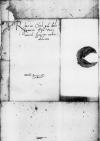List #2970
Bona Sforza do Ioannes DANTISCUSCracow (Kraków), 1546-06-04
| odebrano Heilsberg (Lidzbark Warmiński), 1546-06-25 Rękopiśmienne podstawy źródłowe:
| ||||
Tekst + aparat krytyczny + komentarz Zwykły tekst Tekst + komentarz Tekst + aparat krytyczny
Reverendissimo in Christo Patri, domino
Reverendissime in Christo Pater, sincere nobis dilecte.
Egimus non gravatim cum
Bene valeat Paternitas Vestra.
Ex commissione propria sacrae reginalis maiestatis

